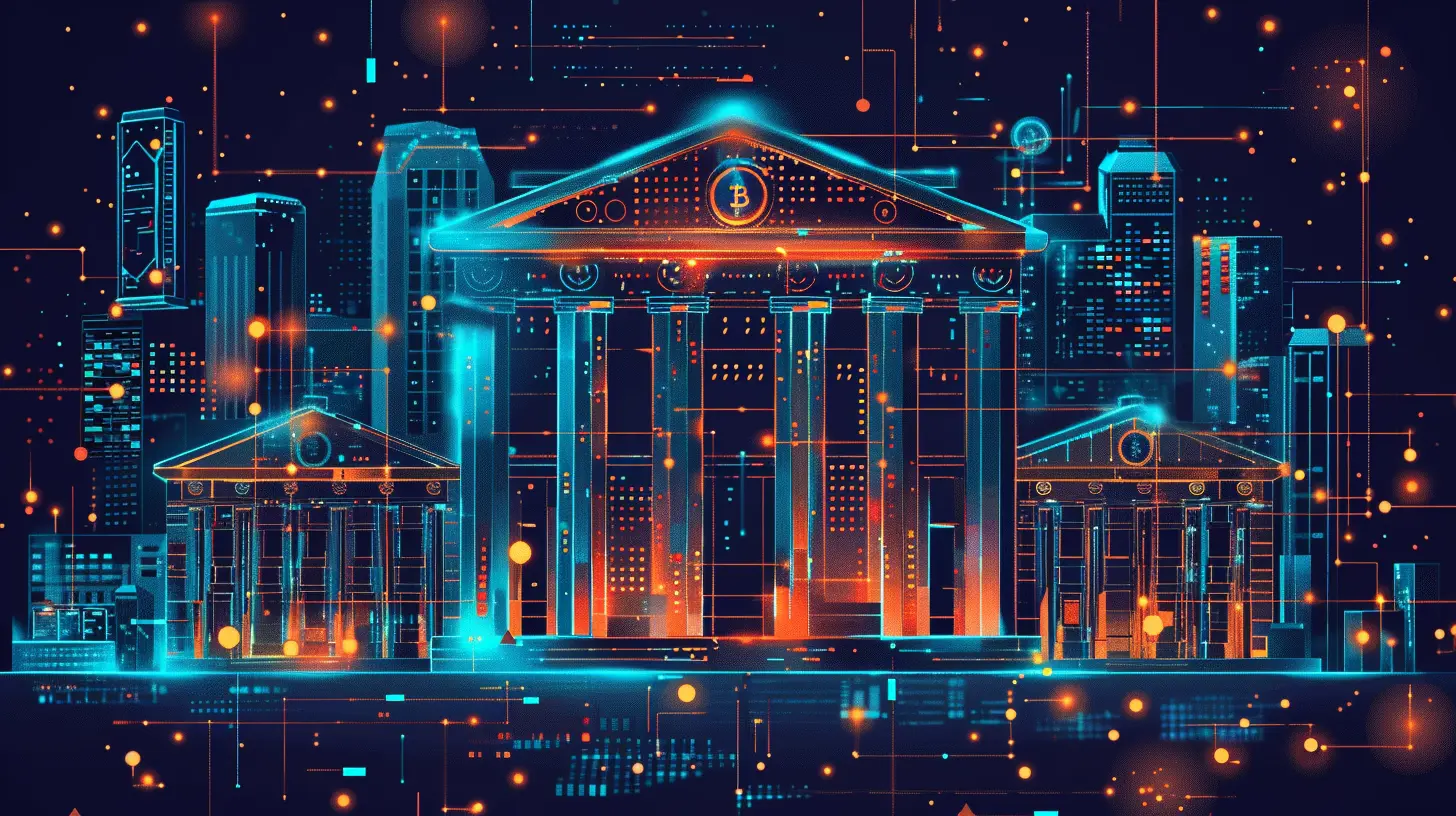How Blockchain is Disrupting Traditional Banking
16 September 2025
Technology is evolving at lightning speed, and one of the biggest game-changers in the financial world is blockchain. Banks have long held the reins of our financial system, dictating how money moves, who gets access, and at what cost. But blockchain? Well, it’s flipping the script.
Blockchain is shaking up the traditional banking system by offering faster transactions, lower costs, enhanced security, and financial inclusivity. Banks have no choice but to adapt—or risk becoming obsolete. So, what's really going on? Let’s dive in. 
What is Blockchain and Why Does It Matter?
Before we get into how blockchain is disrupting banks, let’s break it down.Blockchain is a decentralized, digital ledger that records transactions across a network of computers. Instead of a central authority (like a bank) controlling transactions, blockchain distributes them across multiple nodes, making it transparent, secure, and nearly impossible to tamper with.
Think of it like a massive Google Doc that multiple people can edit in real-time—but once an entry is made, it’s locked in forever. This technology eliminates the need for middlemen, which is exactly why banks are sweating. 
How Blockchain is Shaking Up Traditional Banking
Now, let’s get into the juicy part—how blockchain is disrupting the age-old financial system.1. Faster and Cheaper Transactions
Ever tried sending money internationally? It’s painfully slow, sometimes taking days to process. On top of that, banks slap you with hefty fees—because, well, they can.Enter blockchain-based payments like Bitcoin and Ripple (XRP). These transactions happen in minutes or even seconds, with significantly lower fees. Why? Because blockchain removes the need for intermediaries like banks and payment processors.
For example, Ripple’s payment system allows banks and financial institutions to settle cross-border transactions in real-time for just a fraction of the cost. That’s a massive game-changer.
2. Smart Contracts – Eliminating Paperwork and Delays
Remember the last time you applied for a loan or mortgage? Tons of paperwork, multiple verification steps, and endless waiting. Smart contracts—powered by blockchain—are eliminating all that hassle.A smart contract is a self-executing contract with terms directly written into code. When conditions are met, the contract executes automatically—no middleman needed.
For example, in real estate, instead of waiting weeks for a purchase agreement to go through banks and legal teams, a smart contract can execute the deal instantly once both parties meet the conditions.
3. Financial Inclusion – Banking the Unbanked
Over 1.4 billion people worldwide don’t have access to traditional banks. Why? Because banks require strict identity verification, credit history checks, and high transaction fees—making it nearly impossible for many to open an account.Blockchain is changing the game for the unbanked population. With just a smartphone and a blockchain-based wallet, anyone can store, send, and receive money without needing a bank account.
Cryptocurrencies like Bitcoin and Ethereum allow people in developing countries to access global financial systems without relying on traditional banks. This is nothing short of revolutionary.
4. Enhanced Security – Say Goodbye to Fraud
Bank fraud and cyberattacks are rampant. In 2023 alone, financial institutions lost billions to hackers and fraudsters. Blockchain, with its immutable ledger and decentralized nature, drastically reduces these risks.Here’s why:
- Data on the blockchain can’t be altered or deleted—once a transaction is recorded, it’s on there permanently.
- No single point of failure—traditional banks store data in centralized servers, making them prime targets for cyberattacks. Blockchain distributes data across a network, making hacks virtually impossible.
- Transparency—every transaction is traceable, reducing fraud and corruption.
With blockchain, security isn’t just an afterthought—it’s built into the system.
5. Decentralized Finance (DeFi) – A New Financial System
DeFi, short for Decentralized Finance, is removing banks from the equation altogether. Instead of needing a bank for lending, borrowing, or savings, people are now using DeFi platforms built on blockchain to take control of their own finances.On platforms like Aave, Uniswap, and Compound, users can earn interest, take out loans, and trade assets—all without a bank acting as the middleman.
The best part? No credit checks, no banking fees, and transactions happen instantly. With DeFi, your financial power is literally in your own hands. 
The Banking Industry’s Response
Banks aren’t just sitting back and watching blockchain take over. Some are fighting it, while others are adapting.1. Adoption of Blockchain Technology
Major banks like JP Morgan, HSBC, and Wells Fargo have started integrating blockchain technology into their systems. For example, JP Morgan launched its own blockchain-based digital currency, JPM Coin, to streamline payments among institutional clients.2. Regulation Battles
Governments and central banks are worried about losing control over monetary policies. That’s why there’s been a strong push for cryptocurrency regulations—to ensure banks maintain control (or at least a foothold) in the financial system.However, regulating blockchain isn’t as simple as slapping traditional banking rules onto it. Since blockchain is decentralized, enforcing strict regulations is proving to be a slippery slope.
3. Developing Their Own Digital Currencies (CBDCs)
To compete with blockchain-based cryptocurrencies, governments are creating Central Bank Digital Currencies (CBDCs). These are digital versions of traditional fiat currencies, controlled by central banks.China has already launched the Digital Yuan, and other countries, including the U.S. and Europe, are exploring their own versions. While CBDCs use blockchain-like technology, they still maintain centralized control, unlike decentralized cryptocurrencies. 
The Future of Blockchain in Banking
So, will blockchain completely replace traditional banks? Not necessarily. But it will force them to evolve or risk becoming obsolete.Here’s what we can expect in the coming years:
✅ Faster and cheaper financial services powered by blockchain
✅ Wider adoption of cryptocurrencies for everyday transactions
✅ More flexible lending and borrowing options through DeFi
✅ Governments introducing stricter regulations on blockchain
✅ Banks integrating blockchain-based systems to stay relevant
One thing is certain—blockchain is here to stay, and it’s completely reshaping the financial landscape. Whether banks like it or not, this disruption is unstoppable.
Final Thoughts
Blockchain is not just a trend—it’s a financial revolution. It's demanding a shift from traditional, centralized banking to a decentralized, transparent, and efficient financial system.Banks may still hold power today, but as blockchain technology continues to evolve, their iron grip is loosening. Whether they embrace this change or fight it, one thing is for sure: the future of banking will never be the same again.
So, are you ready for the future of finance? Because it’s already here.
all images in this post were generated using AI tools
Category:
Blockchain TechnologyAuthor:

Michael Robinson
Discussion
rate this article
1 comments
Jett Lozano
This article insightfully highlights how blockchain technology is reshaping the banking sector by enhancing security, reducing costs, and improving transaction speed, ultimately revolutionizing traditional financial systems. Great read!
September 18, 2025 at 3:29 AM

Michael Robinson
Thank you for your insightful comment! I'm glad you found the article helpful in understanding blockchain's impact on banking.


